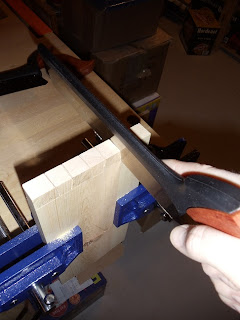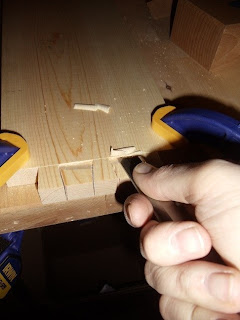OK, maybe not death, more like inconvenience…and Steven Seagal
will not be featured anywhere in this blog entry.
It took a fair bit of time, but I’ve marked (for death) all
of the dowel pin locations on each of the parts for the Rietveld Red Blue Chair. I went over every piece, identifying the
best surfaces and marked (for death), not only the dowel pin positions, but the
orientation of each part as well…tops, backs, inside/outside, etc…
I marked (for death) the center, positioning line on a left-over piece of the Beech chair stock and aligned the bit and fence to drill the centered holes.
After drilling my first test hole I grabbed the dowel stock and tested the fit. Uh oh…either this dowel is not 5/8 inch wide, or this is not a 5/8 inch Forstner bit!
I immediately began to curse Home Depot…those guys mis-marked (for death) these dowels! A quick measurement of the hole’s diameter though revealed the true nature of the problem. This is a 3/4 inch diameter hole! I can’t believe I didn’t notice that before I started growling at Home Depot. A trip over to the box of Forstner bits confused me even more, until it finally hit me…take a look at how these bits are marked (for death) in the box. (Click to enlarge.)
That’s right…the 3/4 inch bit is sitting right smack-dab
above the 5/8 inch marked (for death) slot!
Now in Craftsman’s defense, the bit sizes are clearly labeled on the
shanks, and the plastic, protective covers for each bit are also labeled with
the bit’s correct size, however the marking (for death) on the box is where my
mind went when selecting the appropriate bit to use. I sure hope I remember this the next time I
pull this set out!
With the actual 5/8 inch bit set up and ready to go I
drilled another hole in my scrap piece.
The test fit with the dowel stock was much better this time. Funny what that extra 1/8 of an inch can do
to mess things up. Home Depot isn’t
entirely off the hook though…their 5/8 inch marked (for death) dowel is just a
hair under width, so the fit isn’t as tight as I’d like it to be. I ran a caliper along the length of the dowel
and the width does vary just a little as I worked my way down. The kicker though…it’s never a full 5/8 inch
wide anywhere along the length. The
dowel is Poplar, so it may swell a bit with glue, but I’ll definitely need to
do a glue-up test to be sure. If that
test isn’t successful though, I’ll have to find another source for the dowels…and
this time I’ll be packing my dial caliper to be sure I don’t fall prey to any
more mis-markings (for death.)
On a less deadly note, I was able to find a picture of a Red
Blue chair in the process of being built.
This fellow (G Najran) built several 1:20 scale models of the chair and
made several jigs to aid in construction.
I would have to scale things back up to full size, but there may be some
merit in the way he’s building these models that can translate to my full-sized
reproductions.
Tune in next time to see if I can survive the continued
construction of these “sillas de muerte!”
Pete










































